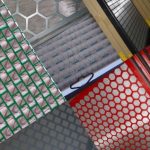
Oilfield shaker screen blinding
Oilfield shaker screen blinding occurs when grains of solids being oilfield shaker screened find a hole in the oilfield shaker screen just large enough to get stuck in. This often occurs during the drilling of fine sands in the Gulf of Mexico. The following sequence is often observed during oilfield shaker screen blinding:
. When a new oilfield shaker screen is installed, the circulating drilling fluid falls through the oilfield shaker screen a short distance.
. After anywhere from a few minutes to even several hours, the fluid endpoint slowly or even quickly travels to the end of the shaker.
. Once this occurs, the oilfield shaker screens must be changed to eliminate the rapid discharge of drilling mud off the end of the shaker.
. After the oilfield shaker screens have been washed, fine grains of sand are observed stuck in the oilfield shaker screen.
. The surface of the oilfield shaker screen will feel like fine sandpaper because of the sand particles stuck in the openings.
Most every oilfield shaker screen used in the oilfield is blinded to some extent by the time it has worn out. This is the reason that when the same oilfield shaker screen size is reinstalled, the fluid falls through the oilfield shaker screen closer to the feed.
A common solution to oilfield shaker screen blinding is to change to a finer or coarser oilfield shaker screen than the one being blinded. This tactic is successful if the sand that is being drilled has a narrow size distribution. Another solution is to change to a rectangular oilfield shaker screen, although rectangular oilfield shaker screens can also blind, with multiple grains of sand. Unfortunately, the process of finding a oilfield shaker screen that will not blind is expensive.
In the late seventies the layered oilfield shaker screen was introduced to avoid oilfield shaker screen blinding. This hook-strip type of oilfield shaker screen was mounted on a downhill sloping unbalanced elliptical motion shale shaker vibrating at 3600 rpm. The two fine layers of oilfield shaker screening cloth, supported at 4-inch intervals, tended to dislodge fine grains of sand and would blind only about 25% of the oilfield shaker screen in severe laboratory tests, leaving 75% of the oilfield shaker screen nonblinded! The nonblinding feature is assumed to be the result of the deceleration of the two oilfield shaker screens. The wire diameter is in the range of 0.002 inch and the opening sizes are in the range of 0.004 inch. In the upward thrust of a layered oilfield shaker screen, the oilfield shaker screens must come to a stop at the upward end of the motion. They would tend to each have an inertia that would prevent them from stopping at exactly the same time. This would
create an opening size slightly larger than the original opening size of the layered oilfield shaker screen during the upward part of the thrust. Solids would be expelled from the oilfield shaker screen. On the downward thrust of the motion, the two layers remain together until the oilfield shaker screen starts deceleration. At the bottom of the stroke, again the inertial forces could cause the oilfield shaker screens to slightly separate, allowing larger solids to pass through the oilfield shaker screen. This probably also explains why the separation cut point curve shows poorer separation characteristics for a layered oilfield shaker screen than for a single square mesh oilfield shaker screen. Many particles larger and smaller than the median opening size are found in the discard from a layered oilfield shaker screen.
Unfortunately, the downhill sloping basket and high frequency limits the amount of liquid that can pass through the oilfield shaker screen. Furthermore, lost circulation material has a high propensity to get stuck in the oilfield shaker screen due to the high-frequency, short-stroke vibration. These problems have been ameliorated by reducing the vibration to 1800 rpm and flattening the basket slope. In the early 1980s, linear motion was introduced so that solids could march up an incline out of a pool of liquid. This fluid pool provided additional pressure to force fluid through the oilfield shaker screen. Unfortunately, linear motion, combined with marginal support, tore layered oilfield shaker screens apart. The only way to obtain satisfactory oilfield shaker screen life on a linear motion machine was to support the layered oilfield shaker screen in 1-inch squares.
we are oilfield shale shaker screen maker, have professional solid control equipment egineers. so if you have any problem about solid control stuff. Please contact us. And here is our shaker screen website.
